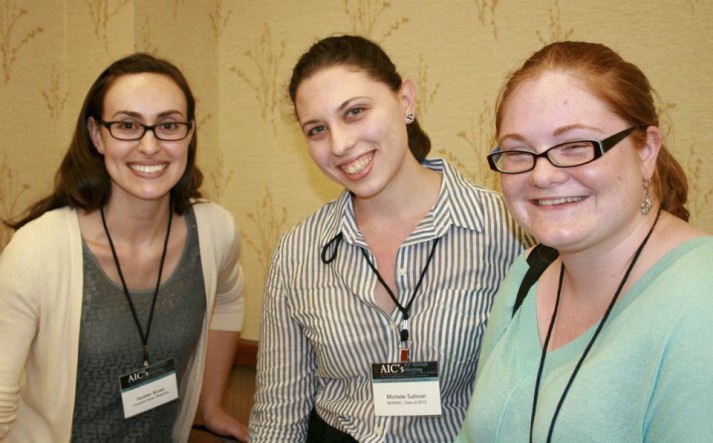The week’s contributing writer, Heather Brown, is a Graduate Fellow in the Winterthur/University of Delaware Program in Art Conservation where she specializes in photographic materials and paper. Heather is currently completing a summer work project at the National Gallery of Art in Washington, D.C., and will move to Houston in September to begin her third-year internship at the Museum of Fine Arts (MFA).
Attending an American Institute for Conservation (AIC) Annual Meeting is an incredible—albeit overwhelming—opportunity for an emerging conservator; the workshops, tours, talks, networking, and more are unlike any other experience that graduate school can offer. I was fortunate to make it to Indianapolis for the 2013 meeting on the theme of The Contemporary in Conservation. There were so many interesting topics compacted into four days, I was actually happy that the photographic materials group sessions were excluded, just so I didn’t have to choose! I learned so much from all of the sessions, but the two that I found particularly engaging were the General Session Panel titled Collaboration in Design: Working with Architects at the San Francisco Museum of Modern Art (SFMoMA) and Part II of the Collection Care Network (CCN) Preservation Planning Discussion Session. In an effort to avoid repeating the abstracts and other blog posts that have already been written, I’d like to share just some highlights of each session.

Heather (left) with fellow emerging conservators Michelle Sullivan and Hannah Mancill in Indianapolis. Photo Credit: AIC
The panel session Collaboration in Design included speakers Ruth Berson and Jill Sterrett from SFMoMA, Craig Dykers of Snøhetta Design, and Sam Anderson of Samuel Anderson Architects, and gave an overview of SFMoMA’s current re-design and expansion project. In summarizing what they were looking for, the specific needs of the collection, and the resulting concepts and design, it was clear that the project provided a productive learning experience for everyone involved. The specific needs of a collection came up again in the CCN discussion when Jim Reilly of Image Permanence Institute advised the audience to think about the big picture and using critical thinking to manage environmental risks. Kristen Laise from Heritage Preservation presented a different approach, underlining the importance of utilizing standards and guidelines as a means of measuring preventive conservation goals. The discussion that followed sided with both speakers in that the current standards aren’t always correct, but conservators sometimes have to refer to the default recommendations for the sake of time and communication.
Although these two sessions were technically about different topics, each addressed the significance of collaboration when planning for collections. Not only did the sessions themselves bring together groups of people to discuss the issues at hand, but the real world case studies also revealed prime examples where conservators were given the opportunity to work with allied professionals. When I see successful results like these, I think it should be an obligation for all conservators to seek out dynamic partnerships in their daily work. Another point made in both sessions was the critical importance of planning ahead for collection care by understanding material vulnerabilities and using that information to define guidelines that reflect the situation at hand. By taking into account new trends and advances in technology and sustainability, it seems beneficial to create preventive conservation standards based on measured environmental data as well as the foresight of what will be best for the collection into the future.
The insights that I gained at AIC have already come into practice in my internship at the National Gallery of Art, where I have assisted with setting up the recently-renovated lab space and have witnessed the amount of teamwork that continues into the final stages of the project. I also hope to apply these ideas this coming year at the MFA Houston, where I will be helping with the planning stages of a new conservation facility by Steven Holl Architects to be completed in 2015. I look forward to continuing discussions about collaboration in preservation planning throughout my internships and at next year’s Annual Meeting Conscientious Conservation – Sustainable Choices in Collection Care in San Francisco. See you there!
